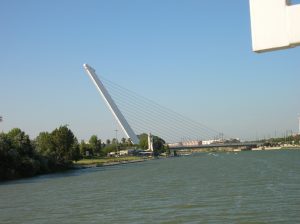I’ve written in this diary in the past about how important travel is to getting the details right in historical fiction. It’s exciting to see how accurately I have portrayed some locations just from researching photographs and descriptions of places, and there is also blessed relief in realizing how much embarrassment I may have avoided by being able to correct what was blatantly wrong.
I’ve also been reminded daily on this trip through Spain and Portugal researching THE SHAPE OF THE WORLD (my novel in progress) that a lot of the value in travel isn’t to confirm or correct details but to discover what simply wasn’t knowable without direct experiences of places or chances to talk with local people. About Sagres, for example, I would probably never have known how much of a factor the wind is in everyday life on the southwest tip of Portugal. The hotel clerk told me, “people who live here think something’s wrong when the wind stops blowing.” Just the three days I spent in the area convinced me that the wind needs to be a dominant part of my description of the place.
Yesterday in Arevalo, north of Madrid, where Isabella (of “Ferdinand and Isabella” fame) spent her childhood, I understood for the first time what Isabella’s mother was up against when she was declared mad and sent away to live in seclusion with her small children in a town so small it isn’t even mentioned in the Michelin Guide and can barely be found on their map.
It was the equivalent of being sent to live in a palace on Alcatraz, a place whose very remoteness and inaccessibility made it a prison even though she lived in luxury. If she wasn’t mad when she went to live there, it’s hard to see how she could have avoided madness afterwards– or perhaps even why she would have wanted to, since there must be some solace in detaching from such a reality. I didn’t have a detailed plot for this part of the story until I understood what life would be like in Arevalo. Now I see so clearly how my protagonist Aya fits into the place that she seems like part of its true history.
And then there are places like Sevilla and Granada, which are wonderful places to visit, but the reality is that with few exceptions, like Granada’s Alhambra Palace, there not much in the urban landscape that hasn’t been rebuilt since the fifteenth century, when my novel is set. The synagogues and mosques are gone and even the churches have gone from medieval to baroque and beyond in their styles. Aya may have sat in the Seville cathedral but none of the decorations that dominate the experience today would have been there. Likewise, taking a boat ride along the Guadalquivir River, I saw a number of amazing modern bridges with stunning archtecture, but had nothing resembling Aya’s experience coming up the same river.

I’m not complaining—I am lucky to be here and having a rich experience—but it’s turned out to be hard to find my story in many of the places I have visited, unlike in Venice, Greece, or France, where I traveled for the first three novels. This is due in large part to the fact that the Reconquista so thoroughly and deliberately reshaped Spain. I was told that if I wanted to know what Granada was like under the Muslim Caliphate I should go to Marrakesh. Sounds good to me—next time!
